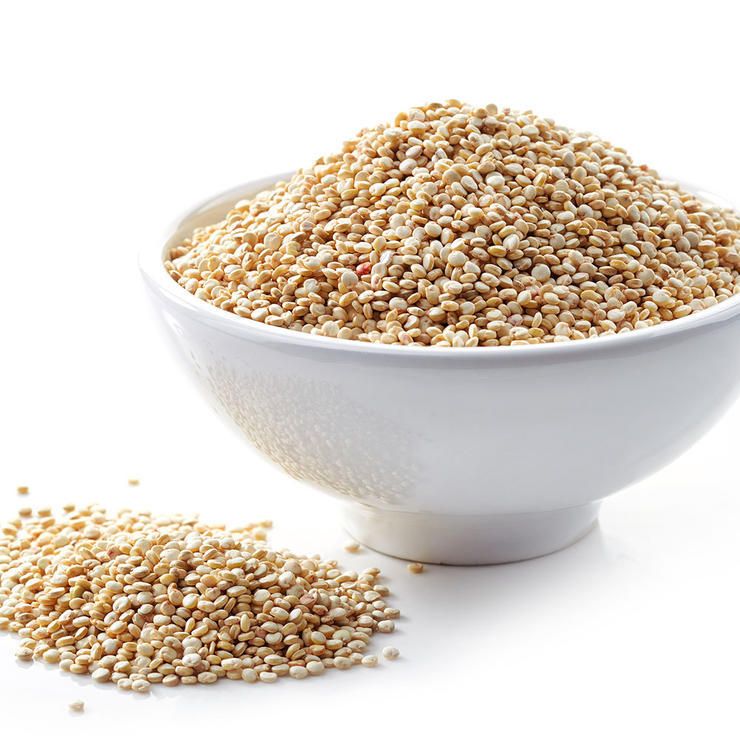

By Julia Westbrook
If you’ve sworn off grains because of the gluten, you could be missing out on a belly full of important nutrients and impressive health benefits.
“Even if you’re gluten sensitive, you don’t have to give up all whole grains,” said Arthur Agatston, MD, author of The South Beach Diet Gluten Solution. “There are many grains that do not contain gluten and that will not cause symptoms.”
Here are six tasty gluten-free grains that can help you lose weight, fight the flu or even make you more fertile. Go with these grains for all of your health goals.
1. Buckwheat

Goal: Get pregnant
Grain: Buckwheat
Couples looking to start a family may want to rustle up some buckwheat pancakes. (Don’t worry, despite its name, the grain doesn’t contain wheat; it’s gluten-free). One hundred grams of buckwheat flour contains 33 percent of the daily recommended allowance of folate, a nutrient shown to improve a woman’s chances of releasing an egg during ovulation. Research from the Eunice Kennedy Shriver National Institute of Child Health and Human Development found that women who had the highest levels of folate were 63 percent less likely to fail to release an egg during ovulation than women who had the lowest levels of folate. Buckwheat is good for men, too, in the baby-making game. Studies show that the folate and zinc in the grain can boost sperm counts by 74 percent.
2. Brown and Black Rice

Goal: Lose weight
Grain: Brown and black rice
Sidestep the white rice, especially if you’re trying to drop pounds. During the refining process, the bran and germ are removed, stripping the rice of its disease-preventing nutrients and satiating fiber. A study published in Nutrition Research found that women who ate a meal replacement made with brown and black rice lost more weight and body fat than those who chowed down on white rice. The study authors attribute this to the fiber differences: White rice has 8 grams of fiber (per 100 grams of rice), while the combo of black and brown rice boasts 23 grams of fiber, leaving the women who ate the black- and brown-rice mix fuller for longer.
3. Quinoa

Goal: Build muscle
Grain: Quinoa
Quinoa (pronounced “keen-wa”) flour makes a healthier alternative to regular wheat flour, especially for athletes looking to boost their protein in order to build strong muscles. A study published in the Journal of Cereal Science found that 100 grams of quinoa flour has 13.5 grams of protein: 29 percent of the daily recommended intake for women and 24 percent for men. (That’s 4 more grams than you’d find in the same amount of whole-wheat flour, by the way). Quinoa can also be served in its whole form as a tasty main course or side dish.
4. Amaranth

Goal: Fuel up for a marathon
Grain: Amaranth
Like most whole grains, amaranth is high in fiber and loaded with health benefits. It can reduce cholesterol and hypertension, and has even been shown to shrink tumors! But amaranth is especially important for endurance athletes. In a study in Nutrition Research, scientists found that amaranth has glycemic index properties similar to white bread. Translation: Amaranth is great for athletes looking to “carb load” before an endurance event like a half-marathon, marathon or adventure race, since studies have shown that foods with a high glycemic index promote fast liver and muscle carbohydrate repletion. In fact, some experts have proposed that amaranth is an above-average starch for athletes since it also provides high-quality proteins.
5. Oats

Goal: Prevent diabetes
Grain: Oats
Oats are loaded with nutrients, including calcium, phosphorus, iron, riboflavin, and niacin.
But the star compound in the gluten-free grain is beta-glucan, a type of dietary fiber. A review of a decade’s worth of studies completed in 2010 found that beta-glucan fights insulin resistance, which leads to diabetes, obesity, high cholesterol, and high blood pressure—all symptoms of an all-too-common disorder known as metabolic syndrome. What’s more, oats serve as a prebiotic to encourage the growth of healthy gut bacteria.
6. Teff

Goal: Beat a cold
Grain: Teff
During colds and flu season, stock up on teff. The grain contains 53 percent of your daily recommended dose of magnesium, 52 percent of zinc and 47 percent of the RDA of iron. Studies have shown that these three elements are vital for immune function. Zinc, in particular, can help reduce the duration of a cold by 3 days, according to a report in The Journal of Infectious Diseases.
This article was reposted with permission from our media associate Rodale Wellness.

 233k
233k  41k
41k  Subscribe
Subscribe 